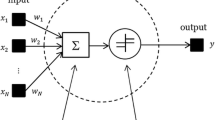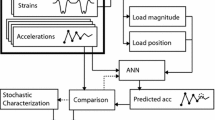Abstract
This paper investigates a model-free damage detection method using a laboratory model of a steel arch bridge with a five-metre span. The efficiency of the algorithm was studied for various damage cases. The structure was excited with a rolling mass and seven accelerometers were used to record its response. An artificial neural network (ANN) was trained to predict the bridge accelerations based on data collected from the undamaged structure. Damage-sensitive features were defined as the root mean squared errors between the measured data and the ANN predictions. A baseline healthy state was established with which new data could be compared to. Outliers from the reference state were taken as an indication of damage. Two outlier detection methods were used: Mahalanobis distance and the Kolmogorov–Smirnov test. The method showed promising results and damage was successfully detected for four out of the five single damage cases. The gradual damage case was also detected, however, for some instances, greater damage did not result in an increase in the damage index. The Kolmogorov–Smirnov test performed best at detecting small single damage cases, while Mahalanobis distance was better at tracking gradual damage.













Similar content being viewed by others
References
Owen W (1959) Special problems facing underdeveloped countries. Am Econ Rev 49(2):179–187. http://www.jstor.org/stable/1816113
Bell B (2004) European railway bridge demography—deliverable D 1.2. Technical report, Sustainable Bridges Consortium
Wenzel H (2009) Health monitoring of bridges. Wiley, Vienna
Gonzalez I, Karoumi R (2015) BWIM aided damage detection in bridges using machine learning. J Civ Struct Health Monit 5(5):715–725. https://doi.org/10.1007/s13349-015-0137-4
Neves AC, González I, Leander J, Karoumi R (2017) Structural health monitoring of bridges: a model-free ANN-based approach to damage detection. J Civ Struct Health Monit 7(5):689–702. https://doi.org/10.1007/s13349-017-0252-5
Khouri CE, Ignacio G, Carmelo G, Raid K (2017) Damage detection in railway bridges using machine learning: application to a historic structure. Proced Eng 199:1931–1936. https://doi.org/10.1016/j.proeng.2017.09.287
ASCE (2013) Structural identification of constructed systems approaches, methods, and technologies for effective practice of St-Id. Am Soc Civ Eng. https://doi.org/10.1061/41016(314)139
Laory I, Trinh TN, Posenato D, Smith IFC (2013) Model-free methodologies for data-interpretation during continuous monitoring of structures. J Comput Civ Eng 27(6):142. https://doi.org/10.1061/(ASCE)CP.1943-5487.0000289
Farrar Charles R, Keith W (2013) Structural health monitoring: a machine learning perspective, 1st edn. Wiley, Oxford. https://doi.org/10.1002/9781118443118
Moyo P, Brownjohn JMW (2001) Bridge health monitoring using waveletanalysis. In: Proceedings of SPIE. The International Society for Optical Engineering, 43 (June): 17. https://doi.org/10.1117/12.429636. URLhttp://vibration.shef.ac.uk/doc/P00351.pdf
Lee SG, Yun GJ, Shang S (2014) Reference-free damage detection for truss bridge structures by continuous relative wavelet entropy method. Struct Health Monit 13(3):307–320. https://doi.org/10.1177/1475921714522845
Moughty JJ, Casas JR (2017) Performance assessment of vibration parameters as damage indicators for bridge structures under ambient excitation. Proced Eng 199:1970–1975. https://doi.org/10.1016/j.proeng.2017.09.306
Wu X, Ghaboussi J, Garrett JH Jr (1992) Use of neural networks in detection of structural damage. Comput Struct 42(4):649–659. https://doi.org/10.1016/0045-7949(92)90132-J
Pandey PC, Barai SV (1995) Multilayer perceptron in damage detection of bridge structures. Comput Struct 54(4):597–608. https://doi.org/10.1016/0045-7949(94)00377-f
Niu L (2012) Monitoring of a frame structure model for damage identification using artificial neural networks. In: 2nd international conference on electronic and mechanical engineering and information technology, pp 438–441
Niu L, Qun C (2013) Structural health monitoring and damage detection using neural networks. In: Third international conference on intelligent system design and engineering applications, pp 1302–1304. https://doi.org/10.1109/ISDEA.2012.307. http://ieeexplore.ieee.org/document/6455402/
Gerard P, Nigel H (2008) ICE manual of bridge engineering, 2nd edn. Thomas Telford, London. https://doi.org/10.1680/mobe.34525.0001
Bilello C, Bergman LA, Kuchma D (2004) Experimental investigation of a small-scale bridge model under a moving mass. J Struct Eng 130(5):799–804. https://doi.org/10.1061/(ASCE)0733-9445(2004)130:5(799)
Danut S, Simon J, Huajiang O, Mottershead John E (2009) Vibration of a continuous beam excited by a moving mass and experimental validation. J Phys Conf Ser 181:1. https://doi.org/10.1088/1742-6596/181/1/012084
Ruffels A (2019) Acceleration data from a laboratory bridge excited using a single rolling Axle. Mendeley Data, V1
Hao S, Oral B (2015) Optimal sensor placement in structural health monitoring using discrete optimization. Smart Mater Struct 24:12. https://doi.org/10.1088/0964-1726/24/12/125034
Fang X, Luo H, Tang J (2005) Structural damage detection using neural network with learning rate improvement. Comput Struct 83(25–26):2150–2161. https://doi.org/10.1016/j.compstruc.2005.02.029
Bishop CM (2006) Pattern recognition and machine learning, 1st edn. Springer, Singapore
Figueiredo E, Park G, Farrar CR, Worden K, Figueiras J (2011) Machine learning algorithms for damage detection under operational and environmental variability. Struct Health Monit 10(6):559–572. https://doi.org/10.1177/1475921710388971
Khoa NLD, Zhang B, Wang Y, Chen Y, Mustapha S (2014) Robust dimensionality reduction and damage detection approaches in structural health monitoring. Struct Health Monit 13(4):406–417. https://doi.org/10.1177/1475921714532989
Santos A, Silva M, Santos R, Figueiredo E, Sales C, Costa JCWA (2016a) A global expectation-maximization based on memetic swarm optimization for structural damage detection. Struct Health Monit 15(5):610–625. https://doi.org/10.1177/1475921716654433
John JM, Joan RC (2018) Damage sensitivity evaluation of vibration parameters under ambient excitation, pp 1–3
Pratt JW, Gibbons JD (1981) Concepts of nonparametric theory. Springer, Berlin. https://doi.org/10.1007/978-1-4612-5931-2
Lilliefors HW (1967) On the Kolmogorov–Smirnov test for normality with mean and variance. J Am Stat Assoc 62(318):399–402
Magel RC, Wibowo SH (1997) Comparing the powers of the Wald–Wolfowitz and Kolmogorov–Smirnov tests. Biometr J 39(6):665–675
Kanji Gopal K (2006) 100 statistical tests, 3rd edn. SAGE Publications Ltd, Thousand Oaks. https://doi.org/10.1177/096228020000900509
Jasper S, Hugo L, Adams RP (2012) Practical Bayesian optimization of machine learning algorithms. In: Pereira F, Burges CJC, Bottou L, Weinberger KQ (eds) Advances in neural information processing systems, vol 25. Curran Associates Inc, New Yok, pp 2951–2959 arXiv:1206.2944S
Santos A, Figueiredo E, Silva MFM, Sales CS (2016b) Costa JCWA machine learning algorithms for damage detection: kernel-based approaches. J Sound Vib 363:584–599
Author information
Authors and Affiliations
Corresponding author
Additional information
Publisher's Note
Springer Nature remains neutral with regard to jurisdictional claims in published maps and institutional affiliations.
Rights and permissions
About this article
Cite this article
Ruffels, A., Gonzalez, I. & Karoumi, R. Model-free damage detection of a laboratory bridge using artificial neural networks. J Civil Struct Health Monit 10, 183–195 (2020). https://doi.org/10.1007/s13349-019-00375-2
Received:
Revised:
Accepted:
Published:
Issue Date:
DOI: https://doi.org/10.1007/s13349-019-00375-2




